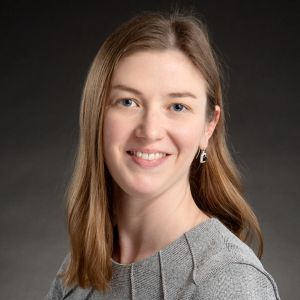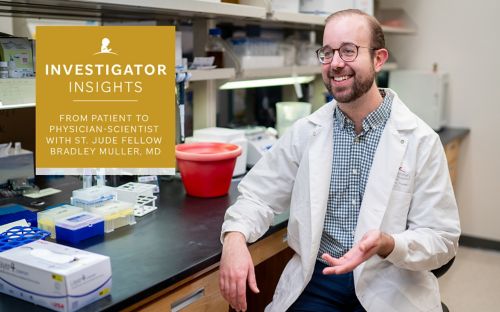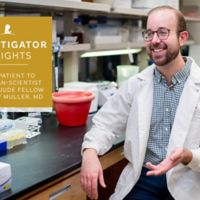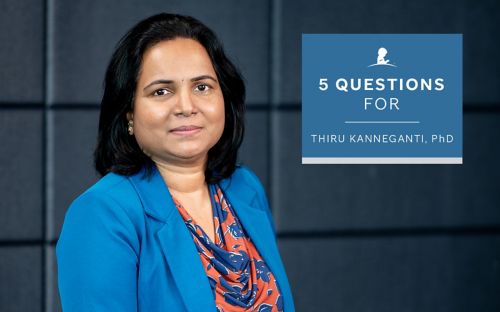5 Questions for Laura Jolovic
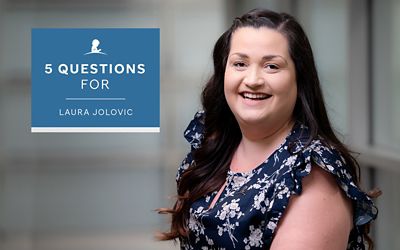
Laura Jolovic, a radiation therapist in the Department of Radiation Oncology is helping provide learning opportunities to students interested in a career in her field.
This question-and-answer series explores the motivations, inspirations and accomplishments of investigators at St. Jude. Laura Jolovic is a radiation therapist in the Department of Radiation Oncology at St. Jude. She provides treatment to children with cancer.
1. What does a radiation therapist do and what kind of patients do you see?
A radiation therapist uses ionizing radiation (protons, photons & electrons) to treat cancer. Radiation therapy is delivered using a machine called a linear accelerator. We work closely with radiation oncologists (who prescribe the treatment), dosimetrists and radiation physicists (who plan the treatment). Our primary role is to safely and accurately deliver the prescribed dose of radiation to the patient. We also play an important role in monitoring the patient’s physical, mental and emotional well-being. We monitor our patients daily for skin changes, fatigue or any other side effects that may warrant a change to their treatment plan. We typically see our patients daily for an average of 30 treatments (Monday through Friday), so we become the face of their radiation therapy. We treat many different types of tumors; some of the more common tumors that receive radiation at St. Jude are medulloblastoma, craniopharyngioma, Wilm’s tumor, rhabdomyosarcoma, other brain tumors such as gliomas, and Hodgkin lymphoma.
2. Why did you decide to become a radiation therapist, and what was your training like?
From a young age, I wanted to work in pediatrics. First, I wanted to become a pediatrician and later I hoped to combine medicine with my love for professional sports to become an athletic trainer for a professional sports team (which was a huge pipe dream). I attended the University of Michigan-Flint with the goal of becoming a physical therapist or athletic trainer, but after several semesters, I decided that this was not the path for me. I came across the radiation therapy program through a high school friend who had applied. Upon shadowing in the clinic at the University of Michigan Medical Center, I knew I had found my home in this profession. A field that combined my love for helping others while also having the opportunity to form a bond with my patients. I find great enjoyment in talking with my patients, learning their likes and dislikes, discussing their hobbies, their families and what plans they have for the weekend or the future. Whether discussing Paw Patrol or college, I love to interact daily with the kids.
My training at the University of Michigan was a 4-year bachelor's degree in public health with an emphasis in radiation therapy. It involved extensive courses in anatomy, biology, physics, medical terminology, radiation biology and many radiation therapy-specific courses. It also included an intensive clinical program that rotated through several clinic sites including the University of Michigan Medical Center and other centers in the Detroit area. This gave us a chance as students to not only experience a wealth of knowledge and treat a broad range of cancer diagnoses from world-renowned radiation oncologists but also to participate in the care of a diverse population of patients. This included age ranges from 3–90+ years of age, differing socio-economic and familial backgrounds, and cultural and ethnic differences.
3. What do you wish more scientists and/or clinicians understood about radiation therapy?
First and foremost, I wish everyone understood what it is we do and that we are different from diagnostic radiographers. Many people think we are MRI, CT or X-ray techs, and while many of us have those credentials as well that is not the purpose of radiation therapy. MRI, CT and X-ray technologists use ionizing radiation to diagnose diseases, while radiation therapists use that same radiation in higher doses to treat diseases, specifically cancer. Diagnostic radiographers and radiation therapists both have enormously important roles within a patient’s treatment journey, but different functions.
It is also necessary to understand that radiation therapy is as precise as surgery. It is essential that a patient hold completely still and not move while the treatment is being delivered, which can range from 20 minutes to over an hour. Our job is to make sure this higher dose of radiation is delivered accurately and safely to the tumor volume prescribed by the radiation oncologist. With the ever-evolving technology of our treatment machines, the accuracy is sub-millimeter. One slight movement can mean a dose to a critical structure that we are trying to avoid. For our youngest and some older patients, we use anesthesia to avoid those movements; for our patients capable of completing treatment without sedation we rely highly on our child life team. They assess ability and compliance as well as support our patient population when necessary during their course of treatment.
4. Mentorship is important in any career, what mentors have inspired you?
My mom is my biggest mentor, she spent 36 years teaching middle school social studies and U.S. history. She taught me the love of helping others achieve their goals and dreams. She always set the bar high for how to behave, how to teach and how to learn.
My father was an immigrant, coming here from the former Yugoslavia (Serbia, specifically). He survived World War II when he was a boy and came to the U.S. in the 1960s when he was in his 20s. Being an immigrant trying to make it here, he taught me how important it was to treat everyone fairly no matter their background. He passed away in 2018, and I like to think the many Serbian patients I have treated since were sent to me by him (it has been about a dozen or so since his passing, and only one or so before). He worked many jobs in the restaurant business and managed several high-end restaurants in New York City and the Detroit area. He gave me his gift for gab and for bonding with people. He never met a stranger and no matter where we went, he knew someone. He taught me how important it is to take the time to get to know people and be intentional with your time. He also taught me how important it is to treat everyone fairly no matter their background.
Lastly, my peers here at St. Jude inspire me. I am the therapist I am today because of them. When I graduated college, a therapist at the University of Michigan Medical Center told me I would learn more in my first year as a therapist than I had in my four years of school. Boy, was he correct. I came to St. Jude having treated 5-10 pediatric patients during my time as a student. This was a whole new ball game. I stood in fear, watching my peers manipulate little heads and bodies on sedated patients. I thought, “I will never be able to do this,” but with their guidance, I learned. I wish I could call them all out by name but there are too many so I will just give a huge thank you to the late Chance Taylor (the best therapist St. Jude has ever had) and Jennifer Bronson. I spent my first six months at St. Jude under their collective wing and they shaped me into the best therapist I can be.
5. You recently hosted a group of students from your alma mater at St. Jude. Why is it important to give students the opportunity to see radiation therapists in action?
Hosting students from my alma mater was such an honor. To even be considered a mentor for young therapists is overwhelming to me. It is so important for students to get the chance to see other therapists in action because you can only learn so much from a book. The personal touch we give each interaction with a patient every day is unteachable. The safe space you create for a patient undergoing a difficult treatment is not found in a book. The little things we do to make a treatment quicker or more comfortable are not written down to study. Having the ability to remember a spouse or sibling’s name or occupation or where a patient is going on vacation or doing this weekend isn’t found in a classroom. All of these things that make our profession so special are found in the clinic, and they can only be found when working with real-life patients, interacting and talking, and most importantly, listening.
Pediatrics is in itself a specialized section of radiation oncology, and many therapy students do not get the chance to spend any time with pediatric patients. So, to afford anyone the chance to watch us interact is a gift. Many people think working at St. Jude is all sadness, and while yes, diagnosis can be sad, each and every day is filled with an immense amount of joy and laughter. Pediatric patients are so special, they are resilient and playful, and they smile and laugh more than any patient I ever encountered in the adult world. They make this job so rewarding, I cannot imagine doing anything else. I am so thankful to have not only the opportunity to host my alma mater but also to work closely with our rotating therapy students from the Arkansas State University and Baptist College of Health Sciences. Shaping future therapists is shaping my potential future peers.
